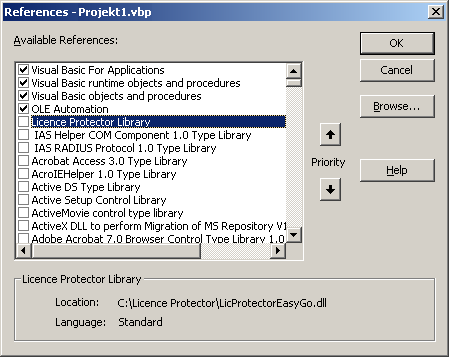
VB6 |

|

|

|

|
||
VB6 |

|

|

|

|

|
|
|
||
First download the VB6 sample from the FAQ area on our website.
•If you use late binding, you do not need to add a reference to the Licence Protector DLL. Note that code completion does not work if late binding is used.
•You can use the Licence Protector object directly with the following command line:
Set lic = CreateObject("LicProtector.LicProtectorDLL313")
•Replace all occurrences of the old object (e.g. LicProtector.LicProtectorDLL250) with the latest version, which is LicProtector.LicProtectorDLL313
•Rebuild your application
•In Visual Basic 6.0 click on the “Project” menu and open the menu item “References…”. Remove the entry "Licence Protector Library" if it is already there

•Then add the new "Licence Protector Library" entry whose path points to the new LicProtectorEasyGo313.dll. The DLL can be found in the folder ....\Licence Protector\3.1\files for distribution\signed-uncompressed
•Now the new Licence Protector object is available in your application.
You can use it with the following command line:
Set lic = New licProtectorEasyGo313
•Replace all occurrences of the old object (e.g. LicProtector.LicProtectorDLL250) with the latest version, which is LicProtector.LicProtectorDLL313
•Rebuild your application
![]() If the application crashes with a memory problem use the COM exe instead of the DLL.
If the application crashes with a memory problem use the COM exe instead of the DLL.
To protect the code against de-compilation or reverse engineering, you can combine Licence Protector with All-In-One Protector for a special bundle price.
See chapter: Code Protection / Decompile Protection